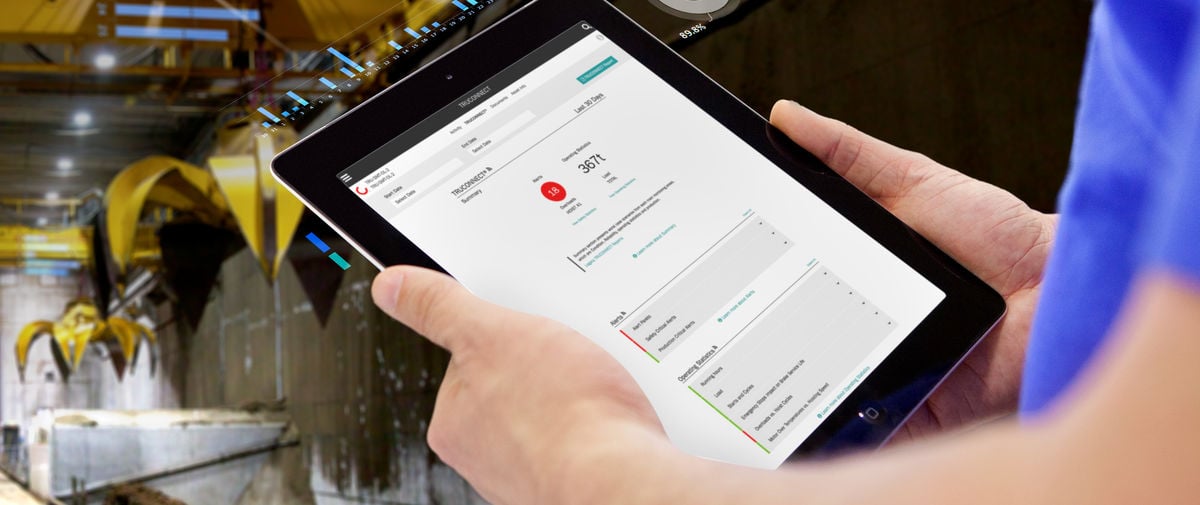Konecranes has put a decade of effort into developing the capabilities for predictive crane maintenance. Data-driven sensors, apps and workflows lie at the heart of the transformation.
Picture an automotive plant making the doors for a certain model of car that’s in high demand. The lights are bright. Skilled workers with protective eyewear are focused on their tasks. Dozens of machines are in use, including cranes that lift heavy materials into place.
Suddenly an alarm sounds and the production line comes to a grinding halt. Everyone puts down their tools and looks up at the problem: the wire rope on a critical process crane has failed. The pressed-steel car doors can no longer be hoisted off the line.
This is more than a simple operational hiccup that can be fixed in an hour – it’s a logistical and financial nightmare as well as a huge safety risk. Production of the finished cars is completely halted and costs can potentially spiral into tens of thousands of dollars per hour.
Could this catastrophic downtime have been avoided? That’s the goal Konecranes is aiming for with its data-driven predictive maintenance ecosystem.
Heikki Rekola is Vice President, Service and Digital Product Management at Konecranes. He’s been working in the crane service business since 2013 and has played a key role in its digital transformation.
“When I started in this industry, service technicians would print inspection reports and deliver them manually to the customer. It could take weeks before a crane owner received the information,” says Rekola.
“Now everything is digital – from the regular on-site observations to the annual summary of the service relationship. The customer is continuously updated on the performance of their equipment. This is thanks to our remote monitoring services, along with the predictive and preventive maintenance capabilities we’ve been rolling out over the past decade,” he says.
Getting the building blocks in place
 One of the cornerstones of the Konecranes maintenance ecosystem is TRUCONNECT, a remote monitoring solution that provides real-time data and insights about crane condition, usage and operation.
One of the cornerstones of the Konecranes maintenance ecosystem is TRUCONNECT, a remote monitoring solution that provides real-time data and insights about crane condition, usage and operation.
TRUCONNECT uses sensors on various crane components to gather critical data, including running time, lifted loads, emergency stops and brake condition. The data is sent to a real-time IoT and analytics platform from which insights can be gathered.
These insights enable Konecranes and crane owners to foresee maintenance needs so that the performance of equipment can be optimized and its lifespan prolonged. Monitoring with TRUCONNECT is not limited to only Konecranes assets.
“Based on advanced predictive maintenance models we receive forecasts on potential faults and replacement needs. Our sales team then initiates contact with the customer to discuss recommended actions,” says Rekola.
“The crane service industry is guided by both statutory regulations and manufacturer-specific requirements. Predictive and preventive maintenance systems capture and track all these protocols so that nothing gets overlooked and equipment owners stay compliant,” he says.
Empowering the field force with data
Digital technologies are also at the core of the workflows for the physical check-ups and maintenance tasks performed on Konecranes equipment.
For example, customers can use Konecranes CheckApp for Daily Inspections to record the basic daily inspections required by law in many countries. A simple swipe gesture confirms the inspection has taken place and observations can be noted.
When a Konecranes field technician is needed for a maintenance task, all the work instructions can be accessed through the SLIM app on their mobile device. The Oracle-based tool – which stands for Siebel Light on Mobile (SLIM) – enables technicians to access service requests, log findings, track safety measures and more. It even works without mobile connectivity.
Jeff Borgmeier is Vice President, Service Processes and Systems at Konecranes. His team is responsible for the SLIM application supporting the company’s 3,000-strong force of field service technicians servicing thousands of cranes each week.
“We started developing the mobile app already in 2015,” he says. “Before we had the app, a technician would need to fill in a stack of paper documentation. Someone in the back office would then be dedicated to inputting these findings into a system. After days – or sometimes even weeks – we'd finally be able to share a report or quotation with the customer.”
“Fast forward to today and we’ve got digital tools that have reduced this process to just minutes. It's a huge advantage for us in terms of the customer experience we can offer,” says Borgmeier.
"Over the years we've built an extensive database of customer assets – right down to serial numbers and manufacturer details. This wealth of information allows us to shift from reactive to predictive maintenance. For example, by tracking the frequency of wire-rope replacements on a hoist we can proactively address equipment needs before they escalate into costly issues,” he says.
The final piece of the Konecranes service package is an AI troubleshooting assistant based on the Mavenoid platform. It’s used by Konecranes technicians to help diagnose and resolve equipment issues.
When a technician encounters a problem, they can describe it in free text within the Mavenoid app. The AI system then engages the technician with questions to identify the root cause of the problem.
“The troubleshooting models implemented within the system are developed by Konecranes. We also built the Mavenoid linkage to the SLIM app,” says Borgmeier. “The tool really improves our efficiency and accuracy in diagnosing any equipment issues.”
Read more about Konecranes digital tools for smart service

 One of the cornerstones of the Konecranes maintenance ecosystem is
One of the cornerstones of the Konecranes maintenance ecosystem is